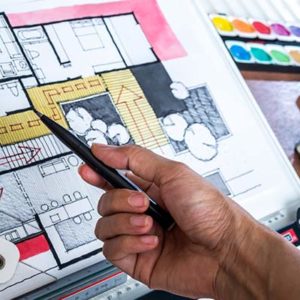
Login
X
- Home
- About Us
- Courses
- Graduation
- Diploma Certificate
- Professional Diploma
- Special sessions / Aptitude boost up
- News & Events
- Student zone
- Placement
- Gallery
- FAQ
- Contact Us

Interior Designing is the art and science of making a space aesthetically useful for its intended purpose. In simple words, it it makes your interiors beautiful and functional. And an Interior designer is the one who does this job. Take your living room, for example. The perfect interior will make sure you get compliments for its looks. And thanks to its thoughtful design, you will only be happy to entertain your guests in it.
Of course, since it is both an art and a science, you should make sure you know those bits before you start with it! Or better still, hire an interior designer who will do it for you. This designer will make sure what exactly you want your space to be and will make it happen.
Well, do you have it in you to be an interior designer? Great! Don’t search further, just read on. This blog will help you to know more about the career, salary, scope, qualifications and other details of interior design.

Interior designer has a very important role to play in today’s world. How we live greatly influences what we become. And so, our homes need to have that edge in them. Also, equally important are places like offices where we spend considerable active hours of our day. Or the malls/arcades that account for your weekend binges. Wait, don’t forget your vacation trips and those luxurious resorts. Who designs them? So here you get an idea about the career graph of an interior designer.
The need of the hour is to preserve nature when you design anything and everything. And if you get the correct training and exposure, you can be a successful and much-in demand interior designer.
Therefore, you can confidently pursue interior design. So the next question that strikes you is how to become an interior designer? At present, there are many courses and programs available to study interior design. Simply click on interior design course to know more.
Interior designer salary depends on many factors. To begin with, the type of work(residential/ commercial/ institutional/ hospitality etc.) is one. Another is the method you choose to calculate your fees. And then the size of the work, location, your role(freelance/ employed in a designated post), nature of work ( interior design/ space planning/ interior decorating/ furniture and furnishings only etc.) also contribute to the decision of your income.
Typically, as a fresher when you work in a design or architecture firm, your salary may be Rs 10,000/- to Rs 15,000/- per month. After two-three years, you can expect Rs 25,000/- to Rs 30,000/- per month depending on your post and firm. Almost all designers undertake extra freelance works which give them additional income and exposure. So in a nutshell, you stand to earn as much as you want to!
You may join as a 3D visualizer, AutoCAD drafts-person or a Site-supervisor. The type of interior design job you select is generally according to your interests. And when you improve with time, you can become a senior interior designer in a firm.
You can be an entrepreneur in any related area of your choice. There are many interior designers who open their own studios in fields like product design, furniture design, lighting, kitchen design etc.
It is a known fact that any person who has a knack for interiors and design can be successful in the field without any formal education. Yet, there are many,many advantages that the formal interior designer qualifications give you. And the basic one is an academic recognition. An interior design degree or diploma makes you eligible to apply for many posts in the design field. Furthermore, you can also go for higher studies in design branches. Also, you can learn the technical parts only if you study Interior design from a good college.
Interior design jobs are constantly on the rise. These days, the building and construction fields are fast expanding. So you can select from a wide variety of job offers. The many options are: work in a studio, supervise a site, focus on interiors only, become a space planner, become a color consultant, manage projects or undertake interior contracts on the whole.
You have a lot to choose from, when it comes to jobs in interior design.
The duty of interior designer depends on the post he/she holds in a company. So as a Draftsman, you create detailed working drawings like plan layout. And if you are a 3D Visualizer, then you work in software that creates realistic images for clients. The workers then replicate these images on site. Sounds exciting, right?!
The interior designer’s responsibility in the site is to supervise everything that goes on in there. And that includes the materials, labor issues, site conditions..everything.
Well, if you are a Project Manager, you are literally running the whole show! Weekly meetings, regular client updates.. you make a lot of teamwork happen! In short, you can be a
There are many Interior designing courses to choose from- right from a short term vocational course, to a one year diploma course and a three year graduate level course. Interior design can make you go beyond yourself. There is so much creativity and passion in it that you tend to celebrate your works. Each work is a new chance to make something new!
To make this happen, a lot depends on you! So, select a good place to study interior design. A place that gives you knowledge and pushes you to explore your design senses. To know more, visit vismayam college of art media

Like any other place in the world, Interior designers create the best space across Indian cities. Hence, the demand for interior designers has increased rapidly in many places. One such region is the tropical south of India. One such state is Kerala. When you design any interior, you should consider the local weather and resources. So, let us find out more about Interior design in Kerala.
The practice of Interior design dates back to Victorian era, when some of the very first designing took place. The reason was simple- a change. Even back then, the need was of decorating according to one’s own choice. If you are wondering whether there is actually any need of a designer in Kerala, think again! Globalization has made big changes in its society, culture and landscape. And you cannot ignore the fact that Kerala has one of the highest literacy rates. Thus as a result, every home owner is well aware of useful designing and its benefits in the long run.

The tropical climate is humid and at times, hot. But, on the plus side, there is a lot of lush greens. This provides the land with a lot of resources- water, land and otherwise. Like with any other place, the traditional construction and interiors have made good use of these. For example, you can see wide use of laterite stones in construction, over modular bricks. No wonder, since it is available abundantly in the state. Moreover, it suits the local climate patterns quite well. One can also find a lot of ceramics (such as roof tiles) and timber products in Kerala homes.
The average Kerala citizen is keen on protecting his/her ecological resources. Hence, home owners want you to preserve and improve the local ecology when you design their houses. They are quite aware of new developments in the field. Thus, people have an easy approach to new materials. There are many who expect you to know all things new in construction market. And so, as a designer it is always exciting to learn and apply new things.
The society is a mix of people from different religions and cultures. And many apply their religious and cultural beliefs to their homes. This adds variety to your design portfolio. A person may prefer traditional Kerala interior. Another family might ask for a Moroccan interior. A bachelor may look for simplicity in his studio apartment. See what I mean here?
Just visit any random supermarket in Kerala. Next to the billing counter, you can see many design magazines on a stand. This gives you a fair idea about the importance of Interiors in the state. And don’t think the designing is limited to public areas. In fact, many people want the latest modular kitchens with trending equipments. Also, there are many who want spa bathrooms! So,the next time, think Kerala when when you think about luxurious settings and decors!
Now, the real question is, how to become a successful interior designer? Apart from the tips in the blog, you should also know your location quite well. Put yourself into regular market surveys. Attend design- related events and competitions. Also,make sure that you are market ready for the profession. And how will you do that?
The answer is quite simple- Join an Interior Design Institute. No, not just any college, but a premium one. Of course, your next question is, how to decide on it? Read ‘best interior design institute in calicut‘. Interior Design in Kerala is huge! Choose the best place to study the art in the state. And you can make it big in the field of Interior Design in Kerala.

The career opportunities in Interior Design have grown rapidly due to the high prospects for competent professionals in design industry. An interior designer gains experience once he/she starts working in the field, either as an employee or as a freelancer and this boosts his/her quality of work. It is therefore very important that one selects a suitable course in interior designing that enables the student to acquire knowledge for better scopes in placements.
While selecting an interior design course, there are many points to consider. Do you want to get just the basics and start designing as early as possible? Or are you looking for a course that provides you all essential elements, but in detail? Are you searching for a short term course that covers all areas of designing? Or are you interested in pursuing designing as your graduation course and then eventually get your career started? To cater to all the above, at present the Interior Design courses are provided at three levels: short term vocational/certificate courses, Diploma courses and graduation/ post-graduation courses.
These courses are often endorsed by independent institutes, often with special focus on any one type of designing, such as furniture designing, product designing, furnishings, lighting, color psychology and application etc.
The diploma courses are ideal for those who are already working professionals but want to explore or expand their career in Interior Designing. These are generally certified by a university or an educational board.
The graduation level courses are three-year programs, with an optional added internship term which can be for a few months to a year.
Each course has its own set of advantages. Depending on what you want to do after learning Interior Design, you can choose a corresponding Interior Design program. With the help of the right faculty team and proper guidance, you can make your dream of becoming a successful Interior Designer come true. Choose wisely!

If interior design has always fascinated you, then you should definitely explore career scope in interior design. The aim is
to become a successful interior designer who is skilled in all aspects of designing, be it space planning, furniture
designing, lighting, landscaping, applying fabric finishes or any other design branch. So the big question is-what are the
areas that have to be extensively understood to start working as an interior designer? Read on.
It remains an effective tool to convey ideas. Freehand sketches, proportional drawings, measured
drawings, projections; rendered illustrations- the category is specifically aimed at making you perfect in
conveying your designs to both laymen as well as professionals. Be it furniture, furnishings or views, graphics
help you in effective visual communication.
Design and architecture are constantly evolving. Naturally, one should be well informed about
existing and useful materials when it comes to construction and design of buildings, furniture and other
elements. A thorough knowledge of materials includes information regarding suitable as well as avoidable
materials according to the local climate of an area. Apart from improving efficient designing, the knowledge of
materials is very important in economizing the total designing process and making the project cost efficient.
Design is everywhere, literally. With increasing emphasis on environment, a designer these days
is expected to apply his/her skills not only to the house, but to its surroundings as well. Shrinking spaces have
led to the popularity of interior landscapes as well, such as courtyards and water bodies.
Interior fabrics such as carpets, curtains, upholsteries, bed spreads, table linen, kitchen linen to name
a few, add that hint of comfort and supple finish to a well defined interior. One should be aware of the vast
collection of soft furnishings available in the market these days, their uses, advantages and disadvantages-
before they are applied to an interior.
What makes an interior attractive? The answer to this question forms the content to be learned in
aesthetics. Apart from effective arrangement of individual interior pieces, it is equally important to understand
the design secrets that add the Midas touch. A successful interior is the result of strategic application of design
principles and elements.
Each member of a family has his/her own choice when it comes to design and color. A clever designer is
successful in making the best of all selections and creating interiors that please the whole family. What comes
handy in that situation? A thorough understanding of colors. The right type of color in the right amount results
in the right outcome.
Some designers have keen interest in taking residential projects, others focus on
commercial sectors. When an interior design student is ready to begin his/her practice, they tend to have a fair
idea about their preferred areas. A multitude of specialties exist, such as kitchen design, product design,
furniture design, color consultancy, lighting and so on.
A building needs some essential services such as plumbing, fire and safety, adequate
heating and ventilation and electricity and interior designers make sure that all required services are
incorporated in a structure at the planning stage itself.
It is not just about Vastu or Feng Shui. Space planning requires in-depth knowledge regarding
building laws, bye- laws and related legal insights. It not only saves time in the planning stage itself, but it also
eases out many steps during construction period for both the client and the designer.
Depending on what course you select, you might learn some more or may superficially cover a particular topic during
course duration. The happy news is, learning does not have an expiry date! Armed with a strong theoretical and practical
base, you can make it big with time, perseverance and experience in the field of interior designing.
In the past, the term ‘Design’ had been frequently associated with Fine Arts and drawing skills. Naturally, a skilled designer was expected to be ‘gifted’ enough to materialize the imagination and concepts with a high degree of precision in every sense-be it the lines, colors or the interpretation styles. All of these demands often proved to be too taxing for a design aspirant, especially for those with limited/restricted sources.

Thus, Necessity proved to be the mother of invention! Technology gave birth to many tools such as computers, software, laptops and the Internet. Everything became available at the click of a button. These sources greatly helped those in need and thus, the creative Design field eventually expanded to Graphic Design, Web Design, Interior Design, Jewelry Design, Fashion Design and the likes.
The Scope in design field is definitely dependent on creativity; however, the fact that hard work beats talent stays true to it. This easily applies to the field of Interior Design. Gone are the days when Interior Design simply meant decorating an enclosed space or rearranging furniture. Today, it requires an aspirant to learn the varied facets in it, right from the basic elements and principles to building construction to landscaping and what not!
Interior design continues to be an exciting career choice. Sure, you can sketch some lines and have an aptitude in color schemes, furniture and furnishings. You want to take it up and pursue, but then this question pops in your head- CAN I REALLY BECOME AN INTERIOR DESIGNER? Here are some points that may help you to decide whether you should really go for it.




Being a highly rewarding field, it is imperative that one selects nothing than the best for studying Interior Design. With so many options, it only makes sense to secure admission in a college that provides the best programs at Graduation/ Diploma Level. To know more, click here
Phone: 0495 272 2242